Praying the Offices
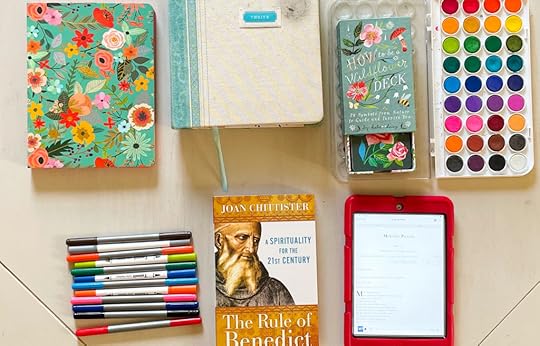
If you read my last blog post, you know that I recently began a new adventure as an Oblate-in-training with the sisters of the Community of St. Mary , a Benedictine order of nuns in The Episcopal Church. And if you are anything like I was just a few months ago, you might know very little about what is involved in discerning if the Oblate life is right for you.
Best I can tell, each order of monastics creates their own processes for joining their community as an Oblate or an Associate. Some are more rigorous than others, some take more time, some less. One of the reasons I was drawn to the Community of St. Mary’s was that it leans towards the more rigorous end of the spectrum. Their program is a two-year discernment, during which candidates (such as myself) engage in things like daily prayer, lectio divina, retreats at the Convent, virtual meetings with a cohort, and reading books and writing reflection papers. As someone who is both hungry for formation within community and deeply interested in spiritual practices, St. Mary’s process is (so far!) a great fit.
And.
It is completely challenging.
As an Enneagram 7w8, ENFP, Rebel, Strategic | Input | Activator | Maximizer | Ideation person, I find that creating daily habits is really hard to implement AND also totally freeing once I break the code to what works for me. It takes a lot of try, try, try, again.
And.
I am totally capable of figuring it out, if I remember that the goal isn’t to get it right the first time. Or even the 30th. The goal is to keep going.
So, now a few months in, I thought I would share a few of the practices I have found to help me in my practices of praying the Daily Offices (of which there are four a day) and engaging in daily Lectio Divina.
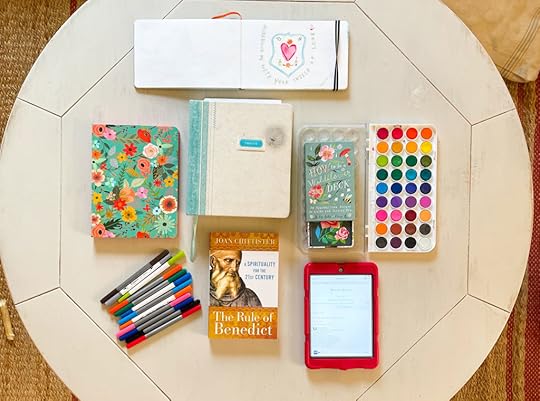
Practice: Lectio Divina
Goal: Practice Lectio Divina 6 mornings a week.
Average: 4 mornings a week
Tools: Journal, Journaling Bible, Markers, Paints, Sketch Book
Doing Lectio almost daily for several months, has confirmed that I am a solid mix of a verbal and a tactile processor. I need to write, draw, and talk outloud in order to get to a place where I can listen. I begin most mornings (because let’s be honest, it’s not every morning) with a strong cup of coffee, my bible, a journal, and some art supplies. Here is my process:
I begin my saying offering a simple prayer to God as I begin. It usually goes something like this: “may I hear/feel/intuit/receive/know what you have for me today. May I listen with the ear of my heart.” Next I read a portion of a Psalm, about 10 verses, (first year of oblate training is all about the Psalms), from my bible. Occasionally, if it seems as if my eyes are just gliding over the words, I will also listen to the passage using Bible Gateway Audio Player in a couple of different translations. I try to listen for the word or phrase that jumps out at me.After a few readings, I write freeform in my journal (totally worth the price because it lays flat!) about the word or phrase that stood out, allowing the images and thoughts that the words invoked to rise to the surface. Sometimes what I write is deeply personal, sometimes it is more about the world at large. Sometimes it takes up two pages, sometimes I only get two or three sentences. Once I am done, I reread what I have written, and then I write a prayer based on what emerged during my journalling.Finally, I sit in silence, offering the prayer and listening for any additional words or images that God might have. Often I use this time to draw or paint images or words that arose during my journalling.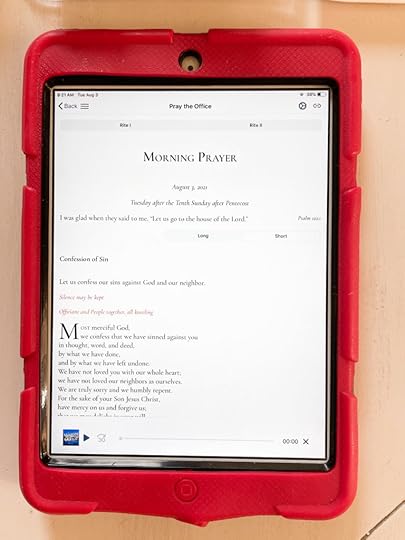
Practice: Daily Offices (Morning Prayer, Noonday Prayer, Evening Prayer, Compline)
Goal: All four offices, 6 days a week
Average: 3 a day, 5 days a week
Let it be known that I have NEVER been good at daily practices beyond eating and sleeping. Those I have no problem practicing with precise rhythm. And, I can now take a daily pill, if it is placed on my nightstand where I will see if before I go to bed. But anything else? Ha.
So as you can imagine, saying prayers four times a day, six days a week is a bit of a challenge. And it might always be a challenge to some degree. But, over the past few months I have discovered some hacks for making sure I practice and engage authentically and with relative regularity (all things considered.)
The Forward Movement App and audio prayers – this app, which I have on my phone and my tablet (as shown above) is the best. It totally saves my praying bacon. Built into the Pray the Office feature are recorded versions of Morning Prayer and Evening Prayer (which are the longest two.) Saying the prayers along with the host makes these practices so much more enjoyable and accessible. I can literally pray anywhere – in the pool, in the garden, in the car, while cooking dinner, on a plane etc. which works really well for me as no two days are ever really identical. This is the app I used the most often for daily prayer.
2. YouTube: However, I do need variety from time to time, so once or twice a week, you can find me saying Morning Prayer with Dean Roberts of Canterbury Cathedral, and all the critters of the deanery. This is a much longer option, as Dean Roberts likes to give a bit of a homily and a history lesson in the middle, but I enjoy the change of pace – it slows me down a bit- and the connection to the land this practice brings.
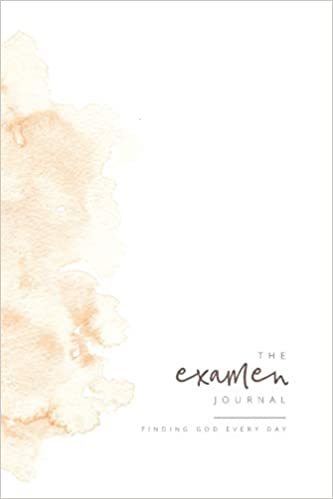
3. The Examen Journal : I had a bit of trouble with finding a good practice for Compline, one that would distinguish it enough from Evening Prayer (because sometimes I end up doing these offices just two hours apart) and make it a little bit more meaningful as as an end to the day. Which is why I was super excited to find this journal. There are four simple questions (which you can read here) and which help me process my day, and prepare for the next as well. I keep it on my nightstand, where I can easily reach it before lights out. I love this journal because it is not dated, and therefore I can just add the dates as I fill it in, and if I miss some, I don’t have huge blank shaming chunks in-between the filled in pages.
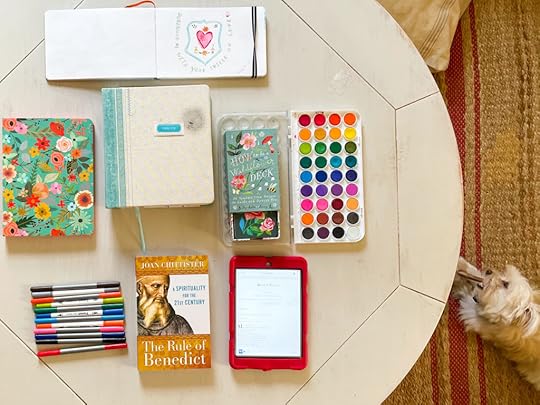
Practice: Reading The Rule of Benedict
There are a few more task on my daily Oblate activities, one of which is reading a portion of The Rule of Saint Benedict each day. Another Oblate-in-Training recommended this version to me, written by Joan Chittister, and I am so grateful. This version is organized by date, so that you read a bit of the rule each day, along with a short reflection/commentary by Chittister, which are all so lovely. She does a great job of making this ancient text accessible for the 21st century just as the title implies, and I find it to speaks to my modern life in surprisingly relevant ways.
So, there is a bit about how I am finding my way through praying the Daily Offices and practicing Lectio Divina regularly. While I sometimes get irritated that I have to stop what I am doing to shift gears and pray, I have begun to notice that on the days I don’t find a way to make the time, I feel less grounded, less filled-up. And right now, I need all the grounding I can get.
PS – While it is not part of my official Oblate practices, I also love to pull one of the Katie Daisy Wildflower cards each day for a little mindfulness inspiration.



